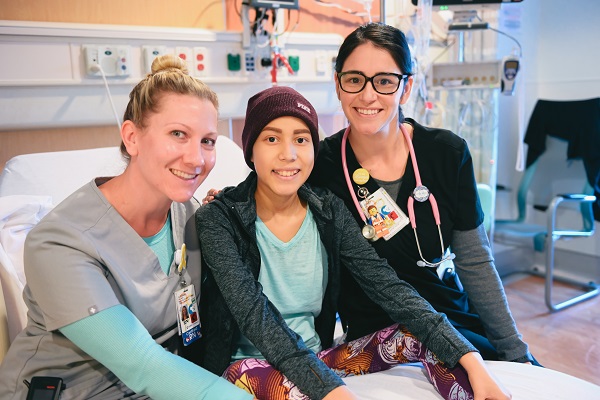
Hodgkin Lymphoma in Children
A Hodgkin lymphoma diagnosis can be overwhelming for families. We understand that a parent’s priority is to understand their child’s options and feel confident in a treatment plan. That’s why our specialists at the Lymphoma Treatment Program provide exceptional care, compassion and open communication throughout treatment.

What is Hodgkin lymphoma?
Hodgkin lymphoma (HL) is a cancer that starts in the lymphatic nodes, and later can spread over different organs and systems throughout the body. The malignant cells in HL are called a Reed-Sternberg cell. Most cases of Hodgkin lymphoma – 9 out of 10 – are classic Hodgkin lymphoma (cHL), which is further classified into four sub-types, three of which are more likely to occur in children.
- Nodular sclerosis Hodgkin lymphoma (NSCHL): This is the most common type of Hodgkin lymphoma, and it’s also most common in teens and young adults. It tends to start in lymph nodes in the neck or chest.
- Mixed cellularity Hodgkin lymphoma (MCCHL): This type of HL, affects mostly young children. and is more common in boys and could be associated with EBV infection
- Lymphocyte-rich Hodgkin lymphoma: This is a very rare HL sub-type. It usually occurs in the upper half of the body and may be found in only a few lymph nodes.
Nodular Lymphocyte Predominant Hodgkin’s Lymphoma (NLPHL) is a rare variant of HL, which is more common in boys and usually presents in early stages. Some cases can progress to a rare type on B-call Non-Hodgkin’s lymphoma.
What are the causes and risk factors of Hodgkin lymphoma?
Genetic factors and some viral infections may increase a child’s risk of having Hodgkin lymphoma, but the exact cause is not known.
Conditions that are known risk factors for Hodgkin lymphoma include:
- Epstein-Barr virus (EBV), which causes mononucleosis (mono)
- HIV, the virus that causes AIDS
- Having a sibling with Hodgkin lymphoma increases 5 times the risk
What are the symptoms?
Symptoms of Hodgkin lymphoma can mimic other common childhood illnesses. Some common signs include:
- Painless swelling of the lymph nodes in the neck, underarm, groin or chest
- Coughing and trouble breathing
- Unexplained fever or drenching night sweats
- Weight loss
- Tiring easily
- Itchy skin
How is Hodgkin lymphoma diagnosed and staged in children?
Your child’s pediatrician will ask about your child’s medical history and symptoms. After examining your child, the doctor may order tests such as:
- Blood tests
- Chest X-ray. The chest X-ray shows the heart, lungs and other parts of the chest.
- Lymph node biopsy. A sample of the tissue from the lymph node is taken and checked with a microscope for cancer cells.
- CT scan. This may be done for the abdomen, chest and pelvis. A CT scan uses a series of X-rays and a computer to make detailed pictures of the body.
- MRI scan. This test is used to check the brain and spinal cord. It may also be used if the X-ray or CT scan results are unclear.
Staging
Diagnosing Hodgkin lymphoma also includes staging the cancer. Staging is the process of seeing if and where the cancer has spread, and it helps your care team decide on a treatment plan.. There are 4 stages of HL:
- Stage I. The cancer is in a single lymph node area
- Stage II. The cancer is in two or more lymph node areas above or below the diaphragm (the muscle that separates the chest and abdomen).
- Stage III. The cancer is in lymph nodes above and below the diaphragm. Or the cancer has spread to lymph nodes above the diaphragm and in the spleen.
- Stage IV. The lymphoma has spread to the organs outside the lymph nodes (metastasis).
How is Hodgkin lymphoma treated?
Most children with Hodgkin lymphoma are treated successfully and cured. The treatment plan will depend on the stage and other factors. Hodgkin lymphoma can be treated with any of the following:
- Chemotherapy. These are medicines that kill cancer cells or stop them from growing. They may be given into the vein (IV), or taken by mouth.
- Monoclonal antibodies. This is a type of targeted therapy that kills cancer cells without harming healthy cells.
- Immunotherapy. Helping patient’s immune system to recognize and kill HL
- Radiation therapy. These are high-energy X-rays or other types of radiation. They are used to killing cancer cells or stop them from growing.
- High-dose chemotherapy with a stem cell transplant. Young blood cells (stem cells) are collected from the child. This is followed by a large amount of chemotherapy, that kills the cancer but causes damage to the bone marrow. After chemotherapy, the stem cells are given back to the patient to help the recovery of the bone marrow.
- Supportive care. Treatment can cause side effects. Medicines and other treatments can be used for pain, fever, infection, and nausea and vomiting.
- Clinical trials. Ask your child’s healthcare provider if there are any treatments being tested that may work well for your child. Learn more about clinical trials at the Cancer Institute.












